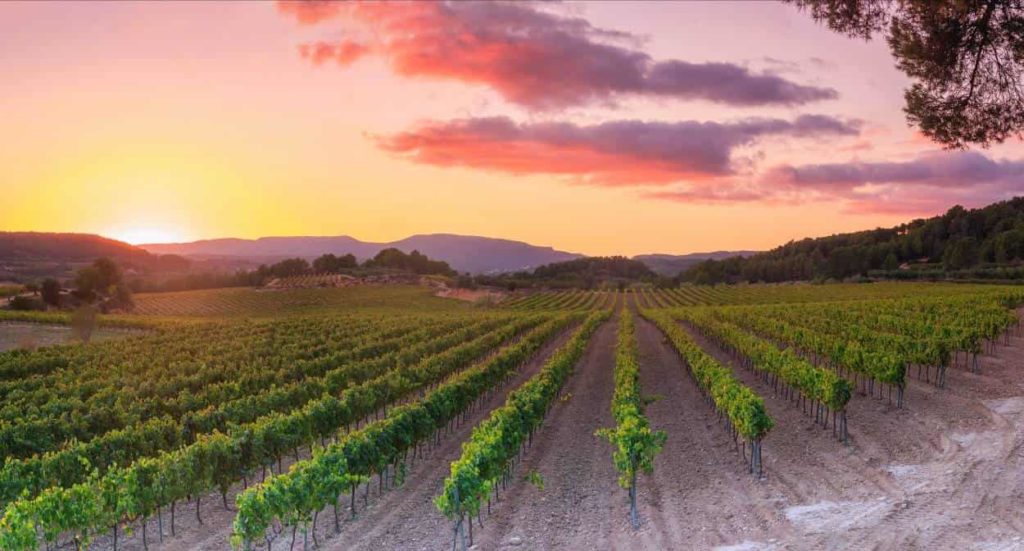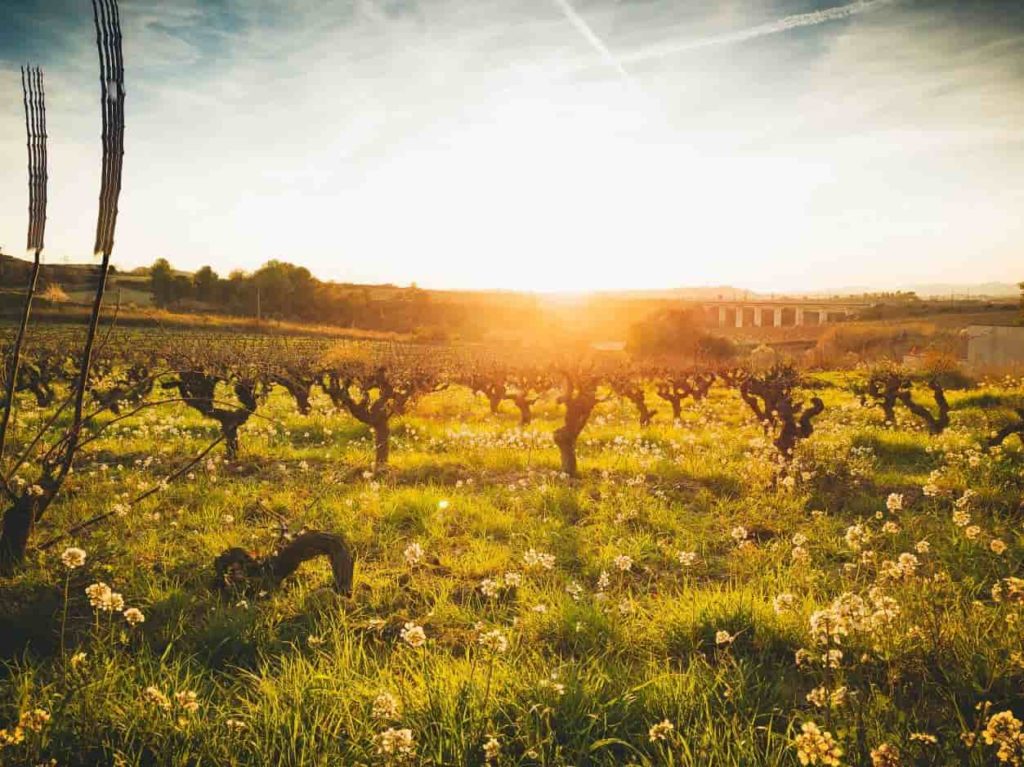
An insight into the Spanish wine regions: Penedès

Penedès, on the doorstep of the vibrant city of Barcelona, has a rich wine history. Winegrowing is said to have begun in the 7th century when Phoenician sailors planted Chardonnay, making the wine region one of Europe’s oldest. The Romans also contributed to ancient wine industry of Penedès. Its proximity to the Port of Barcelona (an essential part of the Roman stronghold over the Mediterranean) makes it perfectly situated for trade along the Via Augusta River. Trade continued in the area, even following the fall of the Roman Empire.
The region is currently known for its white wine production; however, before the 1800s the region was primarily planted with red varieties. The Phylloxera louse (a vine pest) devastated viticulture globally in the mid-late 1800s including those in Penedès. More white varieties were introduced after the region recovered from the outbreak. Despite its image, the Spanish wine region is actually one of the Country’s most diverse, producing a broad palate of red, white, and rosé wines.
Click on a link to jump to that section:
Climate, geography, and terroir
Some of Spain’s best wines – still and sparkling – come from the area centred on the towns of Sant Sadurní d’Anoia and Vilafranca del Penedès. Situated to the west of Barcelona, these vineyards have been cultivated since Roman times. Drenched in summer sunshine, the Penedès wine region enjoys a favourable climate, with mild winters and warm-to-hot temperatures extending from May to October. Proximity to the sea contributes to humidity but can also bring cooling sea breezes. Rainfall is highest in autumn and winter, usually after harvest. Such conditions are responsible for the fruit-forward and concentrated style that characterises the wines of Penedès.
However, there are marked variances in elevation, proximity to the Mediterranean, and aspect can influence the final Penedès wine style. There are two mountain ranges and a valley in the middle of the region, resulting in different mesoclimates and soil types. In recognition of these differences, the authorities have divided the region into three distinct subzones: Baix Penedès, Alt Penedès, and Medio Penedès.
The low-lying vineyards of Baix Penedès are situated west of Sitges, and many of the region’s finest red wines are made in this zone, particularly Grenache blends and Tempranillo. In contrast, specific sites in the Alt Penedès are planted at elevations of up to 800 metres. Local growers wisely exploit diurnal temperature variation to craft fresh and elegant whites in these mountainous vineyards. Finally, the vineyards of Medio-Penedès are planted in a broad valley, with site elevation ranging from 250 to 500 meters above sea level. A large volume of grapes destined for sparkling wine is sourced from Medio-Penedès.

Key grape varieties
Red grapes
- Cariñena (Carignan) – known as Mazuelo in Rioja, Cariñena thrives in the Mediterranean climate of Penedès; low-lying, warmer areas suit it best. Old vines are a precious resource in the region, yielding very intense and spicy wines rich in colour and acid.
- Garnacha (Grenache) – the spicy red grape of the Mediterranean yields Catalan wine, brimming with red fruit and alcohol. It is often blended with Mourvedre in Penedès.
- Monastrell (Mourvèdre) – Mouvedre’s thick-skinned berries produce full-bodied and concentrated red wines in Catalunya, with high alcohol and robust tannins.
- Tempranillo – Rioja’s star red grape is versatile and can grow successfully in various conditions, including Penedès. The wine region’s trademark is velvety red wines of moderate tannins and acidity. They are usually very soft and approachable.
White grapes
The primary white grapes in the Penedès wine region are grown for Cava production. The three grapes that are typically used are as follows.
- Macabeo (Viura) – the mainstay of sparkling wine production, Macabeo yields excellent wine in the higher altitude vineyards of Penedès – ideally suited as the base wine in Cava. It offers lemon-scented fruit and good acidity.
- Parellada – Parellada contributes freshness and perfume to the finest Cavas. The best sites are found at high elevations, where the grapes can ripen slowly and maintain acidity.
- Xarel-lo – Cavas destined for long ageing have a high proportion of Xarel-lo in the blend due to the grape’s generous levels of resveratrol – a natural preservative.
Other varieties
Red grapes
- Cabernet Sauvignon – the late-ripening Cabernet Sauvignon is at home in the warmer terroirs of Penedès. It produces memorable wine: structured, robust and built to last. Its signature aroma is cassis.
- Merlot – Cabernet Sauvignon’s traditional blending partner delivers opulent wines in eastern Spain, noted for its aromas of plum, raspberry, and mocha. Soft tannins are its trademark.
- Pinot Noir – the fussy red grape variety is now a vital part of some premium sparkling rosé wine styles. It brings structure and elegance to Cava.
White grapes
- Chardonnay – increasingly adopted by sparkling wine houses in Penedès, Chardonnay can produce delicate (Champagne-style) whites in this part of Spain. The wines are ripe and buttery, adding plumpness and finesse to Cava.
- Chenin Blanc – the white grape of the Middle Loire can make rich, balanced, and age-worthy wines in the hills of Penedès. But it needs a cool site and limestone soils.
- Riesling – Riesling can make entirely different wines in different places, depending on the soil and climate. Miguel Torres is a prominent advocate of Riesling in Penedès: top vintages are stylish and fresh.
- Sauvignon Blanc – New Zealand’s most famous grape, shows great promise in the cooler parts of Penedès. At best, Catalan Sauvignon Blanc is piercingly aromatic, grassy, and fruit-forward.
Wine styles and designations of Penedès
DO Penedès
Created in 1960, the DO Penedès appellation covers red, white, and rosé wines made across the wider Penedès wine region. Unlike many of Spain’s premier vineyards, there is a longstanding tradition of growing international varieties in Penedès. Indeed, non-native grapes such as Merlot are more widespread in the Catalunya region than elsewhere in Spain; pioneers like Torres introduced modern winemaking techniques and French grapes to Penedès over 60 years ago. Some of Spain’s finest single-varietal expressions are made in these vineyards, including Mas La Plana Cabernet Sauvignon. However, experimentation with local Catalan grapes has shown much promise in still and sparkling winemaking. Variances in terroir and mesoclimate encourage a pleasing diversity of wine styles within Penedès. However, the zone is renowned for its punchy and direct flavours.
DO Cava
Over 95% of Cava is made in Penedès, mainly from the vineyards on a plateau surrounding Sant Sadurní d’Anoia. ‘Cava’, literally meaning wine cellar, could be loosely described as Spain’s imitation of Champagne; Cava gains its sparkle from a secondary fermentation in bottle, just like its French equivalent. Yet the grapes are quite different. The vast majority of local bubbly emphasises fruity Macabeo, which is supported by the fennel-scented Xarel-lo. Meanwhile, Parellada complements this trio by providing perfume and texture to the blend. In recent years, single-vineyard bottlings have become all the rage among Cava producers, marketed as ‘Cava de Paraje Calificado’. The best examples are complex, powerful sparkling wines with depth and finesse.
DO Penedès Espumoso (Clàssic Penedès)
In 2014, the authorities decided to unveil a new sparkling wine category, Penedès Espumoso, marketed under the brand name Clàssic Penedès. Like Cava, it is an appellation for producing traditional method wines, aged for a minimum of 15 months (in this case) before release. However, from the 2017 vintage onwards, all wines marketed as Clàssic Penedès can only be made from organic grapes in the region. This makes it the world’s first appellation exclusively dedicated to organic sparkling wine. So far, the response from consumers has been overwhelmingly positive.
Frequently Asked Questions
What are the major wine regions in Spain?
- In addition to Penedès, Spain’s most iconic wine regions are La Rioja, Ribero del Duero, Priorat, Toro and Rías Baixas. However, there are many wine regions to explore for the red and white wine lover.
Which wine is popular with Spaniards?
- For red wine, DOC Rioja, Ribera del Duero and Priorat are the most popular with the locals. For white wine, Rías Baixas Albariño and Godello are iconic. Other wine styles that Spaniards enjoy are Cava and Sherry fortified wine. A general rule of thumb is to enjoy wine and food from the region you visit.
How is Cava Sparkling wine made?
- Cava is produced in the traditional method of French Champagne production – undergoing a second fermentation in the bottle, which produces the CO2 to make the wine sparkling, as well as imparting bready, toasty flavours. A mixture of still wine and sugar (the dosage) is added later to determine the sweetness of the Cava
What to read next
Spanish wine regions: A guide to Priorat




